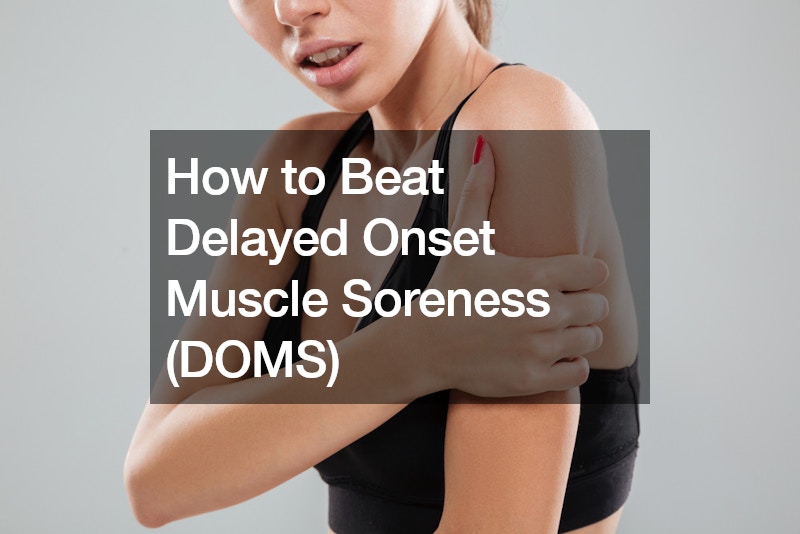
Delayed Onset Muscle Soreness (DOMS) is a common experience for anyone who engages in physical exercise, particularly when starting a new workout routine or increasing intensity. It can be a frustrating hurdle to overcome, but with the right strategies, you can minimize its impact and keep making progress towards your fitness goals.
Understanding Delayed Onset Muscle Soreness (DOMS)
DOMS typically manifests as muscle soreness and stiffness, peaking 24 to 72 hours after exercise. It occurs due to microscopic damage to muscle fibers during exercise, which triggers inflammation and soreness as the muscles repair and adapt. While it’s a natural part of the muscle-building process, excessive soreness can hinder your ability to stay consistent with your workouts.
To further grasp the concept of DOMS, it’s essential to understand that the intensity and duration of exercise play significant roles in its onset. Activities that involve eccentric muscle contractions, such as downhill running or weightlifting, are more likely to cause DOMS. Additionally, individuals who are new to exercise or those who significantly increase the intensity or duration of their workouts are more susceptible to experiencing DOMS. By being aware of these factors, you can adjust your training regimen accordingly to minimize the risk of excessive soreness and optimize your recovery process.
7 Tips to Beat DOMS
Stretching
Stretching after workouts can help alleviate muscle tightness and promote better recovery. While the debate on whether stretching reduces DOMS persists, it does improve flexibility, which is beneficial for overall muscle health. Spend 10 to 15 minutes performing stretches targeting major muscle groups to aid in recovery. Moreover, stretching promotes better circulation, accelerating the removal of metabolic waste products and facilitating muscle relaxation. Incorporating both static and dynamic stretching into your regimen can contribute to overall muscle health and resilience, optimizing your training and recovery process.
Warm Baths
Soaking in a warm bath is a time-honored method for alleviating muscle soreness, as it promotes increased blood flow to the affected areas, aiding in the removal of metabolic waste products and facilitating muscle relaxation. However, caution should be exercised to avoid jumping into hot water immediately post-exercise, as this can exacerbate muscle strain. Instead, it’s advisable to wait until your body has cooled down sufficiently before immersing yourself in a comforting soak to promote recovery.
Massage or Foam Rolling
Both massage and foam rolling are effective strategies for alleviating muscle soreness by enhancing blood circulation, which aids in the removal of metabolic waste products and promotes muscle relaxation. When seeking relief, consider enlisting the expertise of the best massage therapists who specialize in gentle techniques to address soreness or utilize a foam roller on targeted areas to expedite the recovery process. It’s essential to steer clear of rough massages that may exacerbate injury and instead opt for techniques that prioritize relaxation, ensuring a safe and effective approach to muscle recovery.
Omega-3 Rich Foods
Incorporating omega-3-rich foods into your diet can help reduce inflammation and alleviate muscle soreness. A variety of foods, such as salmon, mackerel, sardines, chia seeds, flax seeds, hemp seeds, walnuts, and algae-based sources, provide a diverse array of omega-3 fatty acids to support muscle recovery. Alternatively, you can take fish oil supplements to reap the benefits of these anti-inflammatory nutrients.
Prioritize Rest and Recovery
Getting adequate rest is crucial for muscle repair and growth. Aim for 6 to 8 hours of quality sleep each night and incorporate rest days into your workout schedule. Avoid overtraining, as pushing your body too hard without sufficient rest can prolong muscle soreness and impede progress.
Active Recovery
Engaging in low-intensity activities on rest days can help promote blood flow to sore muscles without causing further strain. Activities like gentle yoga, brisk walking, or swimming can aid in recovery by increasing circulation and reducing muscle stiffness.
Alternate Workout Intensities
To prevent excessive muscle soreness, consider alternating between high-intensity, moderate-intensity, and low-intensity workouts throughout the week. This approach allows for adequate recovery time while still challenging your muscles and promoting overall fitness. For example, you could incorporate high-intensity interval training (HIIT) sessions on Mondays and Wednesdays, followed by moderate-intensity strength training on Tuesdays and Thursdays, and finish the week with low-intensity activities such as yoga or leisurely walks on Fridays and weekends.
The Bottom Line
Delayed Onset Muscle Soreness (DOMS) is common for fitness enthusiasts, but it doesn’t have to derail your progress. By incorporating stretching, warm baths, massage or foam rolling, omega-3 rich foods, rest and recovery, active recovery, and alternating workout intensities into your routine, you can minimize the effects of DOMS and continue making gains in your fitness journey. Remember to listen to your body, prioritize recovery, and stay consistent with your workouts for long-term success.
.



